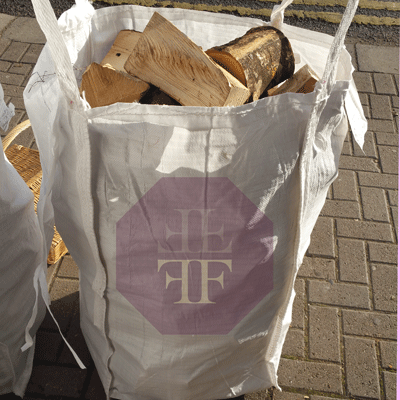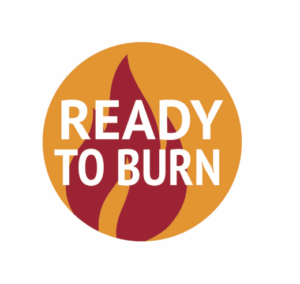
There are a myriad of wood types to choose from, all of which have their own burning qualities and properties and although there are references to burning green wood in this guide, we would stress that for the most efficient and effective burn in your wood burning stove only very dry wood should be used. We have listed below a brief but by no means comprehensive guide.
 Is your firewood Ready to Burn, Labelled as ‘Ready to Burn’ and Is less than 20% moisture content?
Is your firewood Ready to Burn, Labelled as ‘Ready to Burn’ and Is less than 20% moisture content?
Alder: Hardwood Grade: Poor, Produces poor heat output and it does not last well.
Apple: Hardwood Grade: Good, A very good wood that burns slow and steady when dry, it has small flame size, and does not produce sparking or spitting.
Ash: Hardwood Grade:Very Good, Reckoned by many to be one of best woods for burning. It produces a steady flame and good heat output. It can be burnt when green but like all woods, it burns best when dry.
Beech: Hardwood Grade: Very Good, Burns very much like ash, but does not burn well when green.
Birch: Hardwood Grade: Good, Produces good heat output but it does burn quickly. It can be burnt unseasoned, however the sap can cause deposits to form in the flue with prolonged use.
Blackthorn: Hardwood Grade: Good, Has a slow burn, with good heat production.
Cedar: Softwood Grade: Good, Is a good burning wood that produces a consistent and long heat output. It burns with a small flame, but does tend to crackle and spit and the sap can cause deposits to form in the flue with prolonged use.
Cherry: Hardwood Grade: Good, Is a slow to burn wood that produces a good heat output. Cherry needs to be seasoned well.
Chestnut: Hardwood Grade: POOR, A poor burning wood that produces a small flame and poor heat output and spits a lot.
Douglas Fir: Softwood Grade: POOR, A poor burning wood that produces a small flame and poor heat output and the sap can cause deposits to form in the flue with prolonged use.
Elder: Hardwood Grade: POOR, A poor burning wood that produces a small flame and poor heat output.
Elm: Hardwood Grade: Medium, Is a wood that can follow several burn patterns because of high moisture content, it should be dried for two years for best results. Elm is slow to get going and it may be necessary to use a better burning wood to start it off. Splitting of logs should be done early.
Eucalyptus: Softwood Grade: POOR, Is a fast burning wood. The sap can cause deposits to form in the flue and can increase the risk of a chimney fire if burned unseasoned.
Hawthorn: Hardwood Grade: Very Good, Is a good traditional firewood that has a slow burn with good heat output. Hazel: Good, Is a good but fast burning wood and produces best results when allowed to season.
Holly: POOR, Is a fast burning wood that produces good flame but poor heat output. Holly will burn green, but best dried for a minimum of a year.
Hornbeam: Good, A good burning wood that burns similar to beech, slow burn with a good heat output.
Horse Chestnut: Good(for Stoves), A good wood for burning in wood stoves but not for open fires as it does tend to spit a lot. It does however produce a good flame and heat output.
Laburnum: Very POOR, A very smokey wood with a poor burn. Larch: Medium, Produces a reasonable heat output, but it needs to be well seasoned. The sap can cause deposits to form in the flue with prolonged use.
Laurel: Medium, Burns with a good flame but only reasonable heat output. It needs to be well seasoned.
Lilac: Good, Its smaller branches are good to use as kindling, the wood itself burns well with a good flame. Lime: Poor, Not a good wood for burning as it produces very little flame or heat output. Maple: Good, Is a good burning wood that produces good flame and heat output.
Oak: Good, Because of its density, oak produces a small flame and very slow burn, it is best when seasoned for a minimum of two years as it is a wood that requires time to season well.
Pear: Good, Burns well with good heat output, however it does need to be seasoned well.
Pine Species: Good (with caution), (Including Leylandii) Burns with a good flame, but the resin sap can cause deposits to form in the flue and can increase the risk of a chimney fire must be well seasoned.
Plum: Good, A good burning wood that produces good heat output. Poplar:
Poplar: Very POOR, A very smokey wood with a poor burn.
Rowan: Very Good , Is a good burning wood that has a slow burn with good heat output.
Rhododendron: Good, The older and thick stems can burn well.
Robinia (Acacia): Good (for Stoves), Is a good burning wood that has a slow burn with good heat output. It does produce an acrid and dense smoke but this is of course not a problem in a stove.
Spruce: Poor, Produces a poor heat output and it does not last well.
‘Eco’ type of logs and briquettes, In addition there are of course the compressed reclaimed ‘eco’ type of logs and briquettes. Theses tend to burn well and for a decent length of time because they are dense and very dry.
